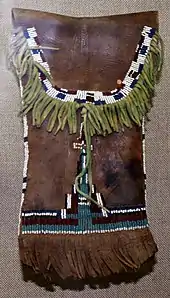Right-angle weave
Right-Angle weave stitch, also known as RAW, is an off-loom bead weaving technique. Beads are stitched together with thread only making right angle turns, hence the name. The result is an almost fabric like piece of beadwork. Right-Angle weave can be woven with either one needle or two.[1] With single needle right-angle weave, the thread path moves in a figure-eight pattern. For double needle right-angle weave, the threads cross each other along the center bead of each stitch as they head in opposite directions. RAW can be formed into flat pieces, tubes, or 3 dimensional figures. There are also variations on the basic stich like cubic right angle weave, or CRAW. Seed beads, fire polished beads and crystal beads are common choices in pieces using right-angle weave. Variations of Right Angle Weave also include PRAW. CRAW is usually worked in sets of four but in PRAW sets can be expanded to 5 +.
History
This stitch is said to have originated somewhere in Africa, but examples can be found in beadwork from many cultures, including Philippines, New Guinea and England.[2][3]
Use
Bead artists are known to use right-angle weave stitch to cover forms, such as vases, beads and other objects.[4]
See also
External links
- http://handmade-jewelry-club.com/2016/05/right-angle-weave-basics-for-beginners.html
- http://www.beadjewelrymaking.com/Arts_and_Craft_Idea/right_angle_weave_instruction.html
- http://www.fusionbeads.com/Right-Angle-Weave-Stitch-Techniques
- http://www.davidchatt.com/hanging-on-by-a-thread/
- http://www.craftsy.com/class/bead-stitching-right-angle-weave/260
References
- Cypher, Carol (2007). Beading workshop : a comprehensive guide to off-loom techniques. Loveland, CO: Interweave Press. p. 108. ISBN 9781596680135.
- Wells, Carol Wilcox (1996). Creative bead weaving : a contemporary guide to classic off-loom stitches (1st pbk. ed.). Asheville, N.C.: Lark Books. p. 94. ISBN 1579900801.
- Blakelock, Virginia L. (1990). Those Bad, Bad Beads! (6th ed.). Oregon: Virginia L. Blakelock. p. 66.
- Wells, Carol Wilcox (1996). Creative bead weaving : a contemporary guide to classic off-loom stitches (1st pbk. ed.). Asheville, N.C.: Lark Books. p. 94. ISBN 1579900801.

